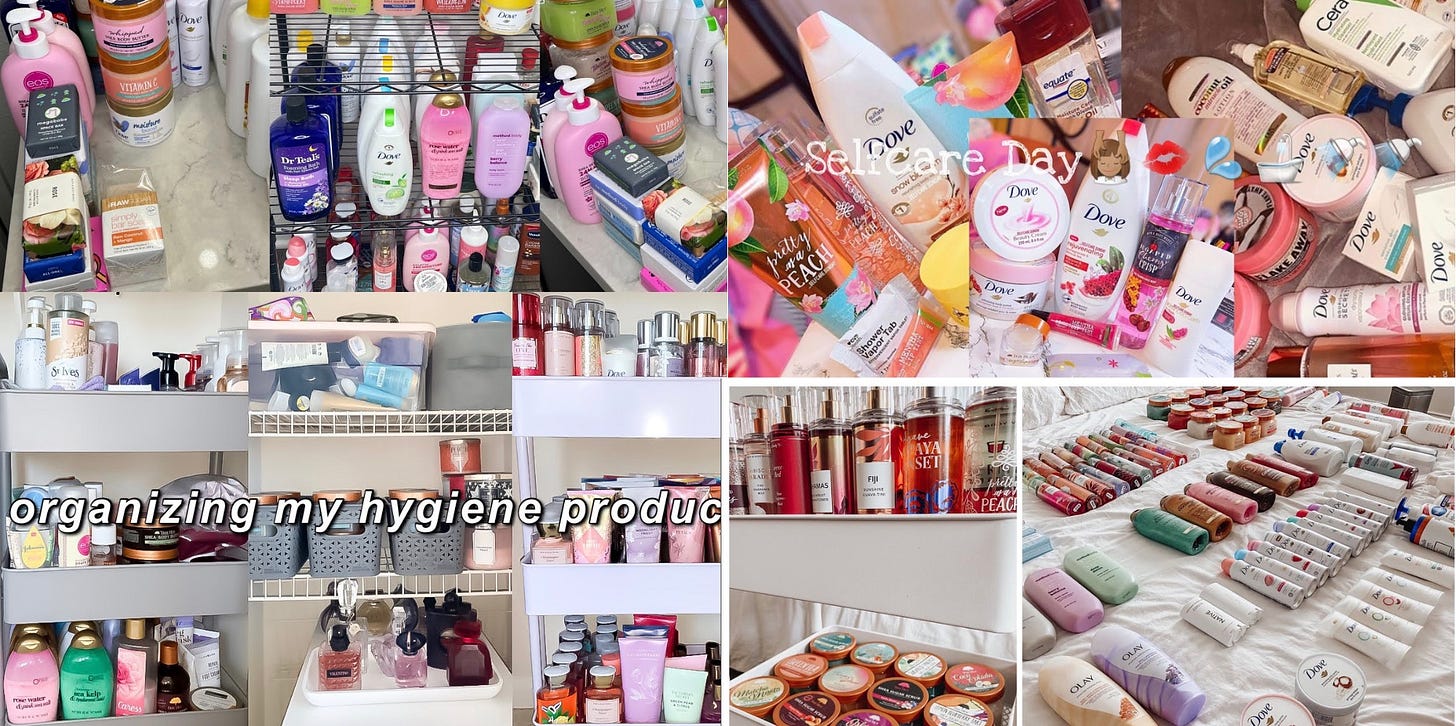In Addition to "Black Women and the Hygiene Olympics" Video Essay
At what point, what are you cleansing yourself of?
Cleanliness is the maintenance and organization of the self. It is both mental and physical. A hygiene routine is for everyone, yet it becomes a gendered system suggesting who is more responsible for maintaining their hygiene.
In her informative YouTube video, “Black Women and the Hygiene Olympics,” Elexus Jionde asserts that women are held to higher hygiene standards than men. Unfair biases are maintained as a result of this rhetoric, leading to false beliefs produced by unrealistic standards.
These beliefs degrade women, but for women of color, they are harmful. Particularly for Black women, it becomes a hyper rhetoric repeated to shame. It distorts the image of Black women and targets them.
On “The Know For Sure Pod,” B. Simone mentions that instead of showering daily, she showers every other day. Co-host Megan Ashley presented the subject, stating how this behavior bothers her. Simone offered the perspective that her busy schedule exhausts her. Instead of spending 20-30 minutes showering, she sleeps.
She faced heavy criticism and disgust from the Black community on Twitter and Instagram. The comments also questioned why she felt the need to share this about herself, whether for attention or clout.
Her statement was perceived as a confession; something she is guilty of as opposed to a reality she can exhibit without feeling shameful about it.
The upkeep of hygiene is a concern of appearance. It’s an aesthetic relevant to the people’s interests and the ideals of presentability. It’s no longer individualistic.
For boys and men, there is an expectation for him to get dirty, so there is tolerance. His hygiene is part of his likelihood. For girls and women, the vitality of her cleanliness is a regulation. Like the systematics of health and safety regulations. Her body is in the public’s interest.
Black women and criticisms about their cleanliness are often a part of our daily culture.
Jionde points out the portrayal of Black women in music created by Black males. The lyrics describe Black women as the sexual interest then proceeds to reduce them as a woman with a dirty genitalia. This discredits the original attraction and talks Black men and their audience out of the original desire.
The desirability stems from women having the anatomical parts a man desires, but suggests she is lacking. With redirection comes a morality to refrain from desiring Black women. Instead, the goal is to categorize Black women as “the sluts and whores they are in society.”
Music created by Black women reveals a need to reject what society presumes. It becomes saturated with a need to affirm their cleanliness or the “supreme pussy” complex. The supreme pussy complex refers to the state of a socially acceptable vagina. One that doesn’t have a stench or works against all the unclean accusations.
It is knowing the vagina is a subject of public discourse and debate. Female private parts are rarely allowed privacy, rather society invades it.
As a result, Black music platforms make Black women feel fear for their natural bodies. It recommends they need to instead alter their bodies. This creates an internal and unconscious need for overcompensation when nurturing self.
The narrative portrays Black girls as incapable of possessing basic human decency.
The internalized perceptions of Black women within the Black community becomes external. It is now a public complex put on display.
—
There was a point in my life when I was curious about other women and their hygiene routines. So like everyone else, I searched the internet, and for the first time, the results predominantly featured Black creators. To be more precise, Black women.
The thumbnails maintained similar patterns of shower shelves filled with products. Almost like a declaration to the world of their cleanliness. Bar soaps, liquid soaps, exfoliation shrubs, feminine wash, shaving creams, shampoos, conditioners, lotions, and perfumes sat in large stock, as if these women were preparing for another pandemic.
After watching various videos, I suddenly felt that my hygiene routine wasn’t good enough. That I needed to take a bar of soap, rub its suds into my washcloth, then add liquid soap for better effect.
Layering products? Multiple showers a day? Isn’t this overcompensating?
The synopsis: The more product sud the better because we could finally cleanse the stench that embraces our skin. The same skin that provokes the stereotypes that presume the status of the bodies of Black girls.
Cleanliness as an Aesthetic
Last year, the clean girl aesthetic became another trend to follow and duplicate. The aesthetic is a minimalist fashion trend portrayed with natural makeup, slicked back hair, and simple clothing and jewelry.
Controversy sparked once many individuals vocalized that for decades, Latinas and Black girls have been doing this look for decades. Now it is trendy.
For Latinas and Black girls, this look makes them appear ghetto and poor. This trope furthers by attaching the baby mama trope to young girls, reducing them as sexually desirable but not worthy of love.
The slick back hair has history in Hispanic, Black, and South Asian cultures. This specific controversy is isolated within America. America holds many cultural communities, yet there are still struggles to integrate and understand one another.
Society still prefers and puts Eurocentric features on a pedestal.
The term “clean girl” is already a loaded term, suggesting one has to be this way or else they are dirty; that they are messy and unorganized. It’s a racially coded term with curly hair and afros perceived as messy and unprofessional.
Since the 90s, Black and Latina girls have worn this look for both everyday wear and professional styling. It stems from an attempt to steer away from accusations of being ghetto, but using minimal hair products because of affordability. Over time, the look becomes liked, but it doesn’t eradicate the appeal of the slick look as a method of assimilation. Styling more textured hair into a flatter appearance, like naturally straight hair.
To be a clean girl and chase this trope is to believe one is finally presentable. This trend reveals a lack of tolerance for women of color by deeming their natural features an unacceptable social mess.
The Desirability Complex
Desirability politics concern beauty standards that establish a hierarchy of existence. Usually, this is racialized and dependent on the physical features of different racial groups.
For Black girls, there is a motive to break any of their potential. It is the act of degrading darker skin tones, how she wears her hair, and her intellect.
It’s a mother on IG live to shame her daughter’s hygiene as punishment rather than teaching her. The aim is to embarrass and mentally torture her daughter, leaving her alienated. It is the constant bullying of young Black girls at any opportunity so they feel insecure and unworthy once she reaches her womanhood.
The Black woman in her womanhood doesn’t want this, so she uses social media to testify to her cleanliness. Otherwise, she can never be beautiful, smart, educated, kind, a good person, a friend, a worthy colleague, or a worthy mother. She can only be these things once she has fought through her struggles and earned those characteristics.
The idea of an acceptable woman depends on a toxic notion of desirability. This requires a rejection of self and a desire to assimilate into the woman who is glorified and regarded as the only presentable type of woman.
The Miseducation of Women’s Anatomy
Ignorance about women’s biology arises from rhetoric that promotes female bodies as possessing grossness.
It begins with the historical hysteria of Aristotle's claim in Generation of Animals.
“The male is by nature superior, and the female inferior; and the one rules, and the other is ruled; this principle, of necessity, extends to all mankind. [...] The female is, as it were, a mutilated male.”
Women being inferior to men, translated into the perception that men are the only ones worthy of recovering from illness or wounds. This led to medical research focused on men’s treatment.
Medical discovery and knowledge developed based solely on recognition of male anatomy. While men reduced women to birth givers who didn’t need scientific understanding. Any biomedical discoveries that worked for men transferred over as reasonable treatments for women.
This not only ignores how conditions may present in the female body but also a need for a doctor who recognizes and studies the female reproductive system.
—
The effects of medical exploitation of Black enslaved women in 1845-1849 by the “Father of Gynecology,” persisted through the 19000s. Black, Puerto Rican, Latina, and Native American women experienced forced sterilizations in hopes of preventing reproduction.
In 1985, only 38 years ago, the US Public Health Service Task Force on Women’s Health stated:
“The historical lack of research focus on women’s health concerns has compromised the quality of health information available to women as well as the health care they receive.”
But it wasn’t until the 1970s-1990s protests further pushed for the wellbeing of women. Doctor Helen Rodriguez-Tras testimony of 1978 recognized that,
“We need health, but above all we need to create a grounding for healthy public policy that redresses and salvages the growing inequalities. We cannot achieve a healthier us without achieving a healthier, more equitable health care system, and ultimately, a more equitable society.”
And it wasn’t until 1998, the Food and Drug Administration (FDA) and The National Institutes of Health (NIH) officiated that women be included in medical research.
In the 21st century, society equates vaginas to the stench of a fish as the leading joke.
—
Reflecting on my earliest and ONLY public discussion of vaginal health, I think of the fifth grade puberty talk hosted by my elementary school.
First things first, a warning about odor.
Odor is deflected before it is instilled into being. The idea of the vagina having an odor, even a natural one, is taught to prevent and mask.
I recall my teacher recommending that once we get our menstrual cycles, we should use perfume and scented period products. It wouldn’t be surprising that most puberty discussions for girls carried this mindset. From adolescents into adulthood, I often hear other girls projecting fears of smelling or believing they smell because they are on their period.
I have experienced this fear myself.
It promotes the need for a feminine hygiene business. A business that preys on women, building insecurities and shame on the natural functionality of their bodies. More than anything, this becomes a performative act that does more harm than good. It develops the risk of yeast infections, bacterial vaginosis, cancerous cells, fibroids, etc.
Doctor Mikhail “Mike” Varshavski, Dr. Jennifer Lincoln, Dr. Emmanuel Aguh MD, and many other doctors have made public statements on social media, mentioning how feminine wash products disrupt the pH balance of the vaginal microbiome. Disruption of the pH balance is due to these products containing chemicals and fragrances.
The vaginal microbiome is a naturally acidic system. Meaning it has a lower pH level of 3.8-5.0. Anything lower or higher than this makes the vagina susceptible to many health risks.
Feminine hygiene products, Yoni steaming, Yoni masks, and deep cleanings promoted by Black businesses are all part of the feminine hygiene business that caters to ignorance.
In order for accurate information about vaginal health to be produced, this business needs to be adjusted, or even dismantled, to eliminate the stigma produced by men and women.
What is misunderstood will be exploited.





